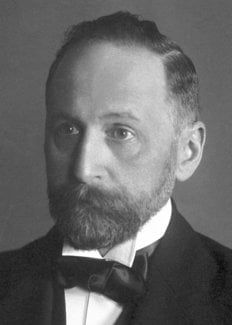Richard Willstätter
Biographical

Richard Martin Willstätter was born in Karlsruhe in Baden on August 13, 1872, and went to school first in his home town and then, when his parents moved house, at the Technical School in Nuremberg. When he was 18 he went to the University of Munich where he studied Science, entered the Department of Chemistry under Baeyer and stayed there for the following fifteen years, first as a student, from 1896 as a lecturer – pursuing his scientific work independently – until in early 1902 he became J. Thiele’s successor as Extraordinary Professor.
As a young man he studied principally the structure and synthesis of plant alkaloids such as atropine and cocaine. In this, as in his later work on quinone and quinone type compounds which are the basis of many dyestuffs, he sought to acquire skill in chemical methods in order to prepare himself for the extensive and more difficult work of investigating plant and animal pigments. For this undertaking the working facilities which the Munich laboratory afforded him were too limited and he was glad to accept the first offer of a Professorial Chair which he received in the summer of 1905. It was thus that he came to Zurich to the Federal Technical College.
These seven years in Switzerland were for him the best and most significant. But while research and teaching brought him great satisfaction, at the same time he suffered personal misfortune and soon became lonely. He enjoyed his work in Zurich so much that he did not think of those years as a waiting period until he was called back to Germany in 1912. For the Jubilee of the University of Berlin, Kaiser Wilhelm had established a Society for the Promotion of Scientific Knowledge and this body had founded an Institute of Chemistry in Berlin/Dahlem. He was offered a Research Laboratory here in conjunction with an honorary professorship at the University of Berlin.
In the two short years before the outbreak of the first World War he was able with a team of collaborators to round off his investigations into chlorophyll and, in connexion with that, to complete some work on haemoglobin and, in rapid succession, to carry out his studies of anthocyanes, the colouring matter of flowers and fruits. These investigations into plant pigments, especially the work on chlorophyll, were honoured by the award of the Nobel Prize for Chemistry (1915), just at the time when he had decided to accept a call to the University of Munich and again, as successor to his old teacher Adolf von Baeyer, take an active part in university teaching; for, as things were then, the even tenour of scientific life at Dahlem was gone.
In the period that followed Willstätter continued on lines of fundamental importance, and his brilliant and fruitful work is regarded today as a pioneering achievement. The investigations into photosynthesis and into the nature and activity of the enzymes were precursory of modern Biochemistry. At that time the method so far developed of concentrating enzymes through adsorption did not make it possible to attain to the crystallized enzymes. In this connexion, Willstätter carried out important studies of adsorbents, metal hydroxides, hydrogels and silicic acids. In addition he was quick to give his attention also to problems of theoretical chemistry. Thus he achieved the first synthesis of cyclo-octatetraene, and went on to compare it with benzene; so also he set up experiments to produce cyclobutadiene.
Willstätter’s career came to a tragic end when, as a gesture against increasing antisemitism, he announced his retirement in 1924. Expressions of confidence by the Faculty, by his students and by the Minister failed to shake the fifty-three year old scientist in his decision to resign. He lived on in retirement in Munich, maintaining contact only with those of his pupils who remained in the Institute and with his successor, Heinrich Wieland, whom he had nominated. Dazzling offers both at home and abroad were alike rejected by him. In 1938 he fled from the Gestapo with the help of his pupil A. Stoll and managed to emigrate to Switzerland, losing all but a meagre part of his belongings.
Willstätter was married to Sophie Leser, the daughter of a Heidelberg University professor. They had one son, Ludwig, and one daughter, Ida Margarete.
The old man passed the last three years of his life in Muroalto near Locarno writing his Biography (Aus meinem Leben, edited by A. Stoll, Verlag Chemie, Weinheim, 1949; English edition From my Life, Benjamin, New York, 1965) until he died on 3rd August, 1942, of a heart attack.
In 1956 a memorial to Richard Willstätter was unveiled in Muroalto.
In an epilogue written by A. Stoll to Willstätter’s Biography the list of honours and distinctions accorded to this great scholar in every part of the civilized world alone occupies no less than three pages.
This autobiography/biography was written at the time of the award and first published in the book series Les Prix Nobel. It was later edited and republished in Nobel Lectures. To cite this document, always state the source as shown above.
The Nobel Foundation's copyright has expired.Nobel Prizes and laureates
Six prizes were awarded for achievements that have conferred the greatest benefit to humankind. The 14 laureates' work and discoveries range from quantum tunnelling to promoting democratic rights.
See them all presented here.
